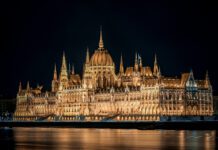 The neon signs in Oklahoma City’s Automobile Alley are a nod to the area’s colorful past. Photo by J. Christopher Little.
The neon signs in Oklahoma City’s Automobile Alley are a nod to the area’s colorful past. Photo by J. Christopher Little.
It’s flashy, colorful and nostalgic – what’s not to love about neon? Jim Gleason of Superior Neon Signs says that neon has been turning heads ever since its appearance almost a century ago.
“Neon had a huge impact when it was new. Almost all signs during its heyday were made of neon,” Gleason says. “It not only impacted Route 66, it impacted the entire world.”
Shops like Superior Neon and Claude Neon opened in Oklahoma at the beginning of the craze, Gleason says.
“Very few companies could make these signs [at the time] due to the fact that it was a very scientific process,” he says. “Today, there are still engineers in the LED field that are trying to do better than neon. So far it has not been done.”
The nostalgic value of neon causes some to collect the signs. Collector and businessman Sam Stokely has helped transform a former neon sign shop into the Stokely Event Center in Tulsa.
“All the light [at the event center] is generated by neon alone,” Stokely says. “It is hard to describe – it must be seen in person.”
Like Gleason, Stokely also believes that neon, although maybe not as widely used, is here to stay.
“Neon is just as popular and reliable today as it was in the 1950s and ‘60s,” Stokely says.
Existing examples of neon signs related to Route 66 include the Tower Theatre sign in Oklahoma City, the rehabilitated sign of Rock Café in Stroud and the Meadow Gold sign of Tulsa. The Tulsa Architectural Foundation also recently conducted a survey of the city’s 198 sign locations.
With major improvements made to neon design beginning in the ‘90s, the process is almost the same as it was decades ago but requires little maintenance, Gleason says.
“Some districts, such as Automobile Alley, are bringing these [neon signs] back,” Gleason says.
So while there might be fewer Cadillacs driving along Route 66 these days, it seems that neon’s long history in Oklahoma has not yet reached its final destination.






















 The neon signs in Oklahoma City’s Automobile Alley are a nod to the area’s colorful past. Photo by J. Christopher Little.
The neon signs in Oklahoma City’s Automobile Alley are a nod to the area’s colorful past. Photo by J. Christopher Little.


